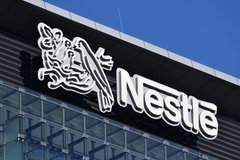
- Industry news
Industry news
- Category news
Category news
- Reports
- Key trends
- Multimedia
- Journal
- Events
- Suppliers
- Home
- Industry news
Industry news
- Category news
Category news
- Reports
- Key trends
- Multimedia
- Events
- Suppliers
Gut health, sugar reduction and personalization trends drive functional beverage innovation

Functional beverage innovations are moving beyond general well-being to become personalized, plant-powered, and gut-friendly. The rising demand for convenient, health-focused drinks is fueling advancements in pea proteins, prebiotic fibers, and botanical extracts, along with practices like regenerative agriculture to ensure sustainability in the supply chain.
The category grew by 8% (average annual growth) from 2020 to 2024, with functional claims in 72% of soft drink launches and 28% of hot drinks, indicates Innova Market Insights data.
Food Ingredients First speaks with Cargill, Ingredion, Nexira, SVZ, and Tirlán to understand how the sector is addressing challenges in the formulation and sustainability of functional beverages.
“Consumers are increasingly prioritizing health and wellness in their purchase decisions. This trend is evident as 41% of sports and functional nutrition consumers are influenced by health attributes,” says Karla Eggleton, director of marketing and global beverage lead at Ingredion Mexico.

“Additionally, Ingredion Proprietary Texture Consumer Research shows the majority of consumers prefer products with natural ingredients, with 72% favoring items that contain no artificial ingredients, preservatives, or additives. Three in four consumers find the “natural” claim appealing.”
Charlotte Wallart, Nexira’s product manager for Food, agrees: “Consumers are increasingly seeking clean label products that offer both health benefits and a natural ingredient list.”
“This trend is driven by a desire for transparency, sustainability, and ethical sourcing, which aligns perfectly with the use of botanical extracts in beverages.”
 Consumers desire transparency, sustainability, and ethical sourcing in functional beverages, says Wallart.
Consumers desire transparency, sustainability, and ethical sourcing in functional beverages, says Wallart.
Botanicals in focus
Functional beverage trends indicate a sharpened focus on natural and botanical ingredients, with a “strong positive sentiment” around botanical ingredients on social media. Nearly 61% of mentions are positive, Wallart continues.
Botanical extracts enhance flavor while meeting consumer demand for “naturalness and responsible food choices.”
Acacia fiber “supports digestive comfort” and can be used as a prebiotic ingredient for soda as it is stable at low pH and high temperatures. Nexira’s guarana extract with a high caffeine content can be added to energy-boosting beverages, she adds.
Meanwhile, hibiscus extract offers antioxidant properties, pink to purple hues, and a “fruity, slightly tart flavor,” while lemon balm extract imparts calming and relaxation properties.
Transitioning from sports to personalized nutrition
Chris Squire, commercial director specialized nutrition, EMEA at Cargill, points to the evolution of functional beverages “beyond traditional sports nutrition.”
“Consumers are increasingly seeking products that support holistic wellness, encompassing physical performance, cognitive function, immunity, and gut health.” He also highlights a substantial shift toward plant-based alternatives such as pea protein.
“Approximately five out of ten (50%) of product launches from 2019 to 2023 carried a “high protein” claim, indicating sustained interest in muscle recovery and maintenance, according to Cargill’s proprietary research (Nutrition Integrated 2024).
Personalized nutrition is gaining traction too, with more people seeking tailored nutritional solutions for healthy aging and sustained energy, he adds.
 Consumers are gravitating toward RTD options like protein drinks and wellness shots for convenience, says Collins.Avril Collins, marketing manager, Ingredients at Tirlán, agrees that consumers are “looking for beverages that cater to their specific health needs — whether it’s weight management, cognitive support, digestive health, or immune function.”
Consumers are gravitating toward RTD options like protein drinks and wellness shots for convenience, says Collins.Avril Collins, marketing manager, Ingredients at Tirlán, agrees that consumers are “looking for beverages that cater to their specific health needs — whether it’s weight management, cognitive support, digestive health, or immune function.”
“In response, brands are innovating with targeted formulations, creating a more customized consumer experience.”
Driving convenient formats
Convenience remains a major driver in beverage demand from consumers striving to balance work and personal life, Collins continues.
“With fast-paced lifestyles, consumers are gravitating toward ready-to-drink (RTD) options that are easy to consume while on-the-go. This trend is reflected in the popularity of formats like protein drinks and wellness shots, which deliver quick, effective benefits in an easy-to-consume format.”
Similarly, Eggleton says that ready-to-mix (RTM) formats that fit seamlessly into consumers’ daily routines are gaining ground, besides on-the-go mini protein shakes and protein waters.
Ingredion’s “80% pea protein” ingredient Vitessence Pea 200 D enhances RTM protein beverage experience for consumers by offering faster dispersibility, reducing sedimentation, and ensuring a “smooth, grit-free texture.”
Additionally, functional yogurt drinks and pouches targeting immunity, protein intake, and bone health are gaining traction, offering “convenient nutrition in a familiar format,” says Johan Cerstiaens, commercial director at SVZ.
However, he observes that consumers feel “lost” among product choices and suggests manufacturers use simpler labels and claims like low sugar, high fiber, vitamins, minerals, and familiar ingredients like fruit and vegetable juices, concentrates, or purees to “fill the gap left by complex or unfamiliar labels.”
Leveraging protein and fiber for gut health
According to Cargill’s Squire, nearly “one-third” of global consumers experience digestive issues and six out of ten (63%) active consumers aim to improve their gut health.
“The gut-muscle axis is set to become a major focus for innovation in active nutrition as it merges two powerful trends: the importance of maintaining muscle mass to be your healthiest, and the well-being associated with preserving a healthy gut.”
 Prebiotic sodas are gaining popularity in gut health innovations (Image credit: Nexira).“Emerging scientific evidence suggests that supplementing pea protein with resistance exercise leads to similar muscle synthesis benefits as traditional protein sources. Cargill’s RadiPure/Puris Pea Protein solutions provide an optimal amino acid profile along with additional nutrients.”
Prebiotic sodas are gaining popularity in gut health innovations (Image credit: Nexira).“Emerging scientific evidence suggests that supplementing pea protein with resistance exercise leads to similar muscle synthesis benefits as traditional protein sources. Cargill’s RadiPure/Puris Pea Protein solutions provide an optimal amino acid profile along with additional nutrients.”
Cargill’s soluble fiber has good gastrointestinal tolerance and supports “beneficial gut microbiota,” offering a prebiotic effect with a recommended use of 5-25g, Squire says.
Additionally, fermented beverages, such as kombucha, continue to appeal due to their gut health benefits, says Cerstiaens. Dietary fibre is also gaining popularity among consumers looking for “simpler, tried and tested” nutritional claims.
“Fiber-rich vegetable ingredients are the perfect way for beverage manufacturers to meet this demand, with a fiber content to calorie ratio of 1:10 in some cases.”
Overcoming stability challenges
Squire says the biggest challenge in functional beverage formulation is achieving the right balance between nutritional efficacy, sensory experience, and stability over shelf life.
“Taste and mouthfeel are critical factors, as many functional ingredients, including proteins, fibers, and biotics, can introduce undesirable flavors or textures. Solutions such as EverSweet stevia sweetener can bring a clean taste profile.”
 Ensuring the bioavailability, taste and stability of functional beverage presents challenges, says Eggleton.Ingredient interactions also affect functional beverages’ solubility, stability, and bioavailability. He adds that shelf stability is another key consideration, particularly for ingredients such as probiotics and postbiotics, which can degrade over time.
Ensuring the bioavailability, taste and stability of functional beverage presents challenges, says Eggleton.Ingredient interactions also affect functional beverages’ solubility, stability, and bioavailability. He adds that shelf stability is another key consideration, particularly for ingredients such as probiotics and postbiotics, which can degrade over time.
For Eggleton, ensuring the bioavailability of nutritional ingredients throughout the product’s shelf life is a significant challenge, along with taste. “Many high-protein formulations have off-notes or bitterness, requiring extensive flavor masking.”
“Our ingredient innovations offer clean, neutral taste profiles, reducing the need for masking agents and allowing formulators to create more authentic and appealing flavors.”
Sugar reduction drives regulatory focus
Eggleton says that regulators will tighten scrutiny as functional claims grow more complex. Brands must balance innovation with clear, science-backed messaging to ensure consumer trust and compliance.
“For example, in response to Colombia’s new sugar tax, which began at 10% in 2023 and will rise to 20% by 2025, beverage manufacturers are proactively seeking strategies to reduce sugar content.” These include using sugar substitutes like stevia, monk fruit and allulose.
Cerstiaens also believes regulatory changes around sugar reduction are impacting businesses. “As governments worldwide introduce sugar taxes and front-of-pack labeling systems like Nutri-Score gain traction, particularly in Europe, brands are actively reformulating their products to comply with evolving standards while maintaining consumer appeal.”
However, he states that substituting sugar in beverages goes “beyond taste,” as sugar also confers bulk and textural benefits to beverages.
“One solution to this is white vegetable purees, which can be a low-sugar, effective base ingredient. Examples include white carrots and white pumpkins used in SVZ’s Carte Blanche concept, which can be crafted for bases that are naturally low in sugar.”
Driving food resilience with regenerative agriculture
Collins sees sustainable sourcing and regenerative agriculture as essential to functional beverages’s future, as consumers prioritize origin, environmental impact, and clean labels.
 Transitioning to regenerative agriculture is important for a robust food ecosystem, says Cerstiaens.“Tirlán is committed to working with local Irish dairy farmers and grain growers who implement regenerative agriculture principles — focusing on soil health, biodiversity, and responsible land management. These practices not only enhance the nutritional quality of our dairy and plant-based ingredients but also help support long-term farm sustainability.”
Transitioning to regenerative agriculture is important for a robust food ecosystem, says Cerstiaens.“Tirlán is committed to working with local Irish dairy farmers and grain growers who implement regenerative agriculture principles — focusing on soil health, biodiversity, and responsible land management. These practices not only enhance the nutritional quality of our dairy and plant-based ingredients but also help support long-term farm sustainability.”
The company integrates grass-fed dairy and sustainably sourced plant ingredients into functional beverages to give consumers high-quality nutrition while supporting a lower environmental footprint.
However, transitioning from current methods to regenerative farming will be a challenge, but is critical to ensure a “resilient and robust” food ecosystem, flags Cerstiaens.
“Working closely with customers, ingredient suppliers can adapt their sourcing practices to prioritize and invest in regenerative farming partnerships, including matching funding, paying a price premium for raw ingredients, and committing long-term to certain volumes of a specific crop.”
Meanwhile, Nexira secures premium-quality sourcing through sustainable partnerships with local growers and prioritizes transparency, says Wellart.
Emerging segments and trends
Wellart expects botanical extracts to play a central role in functional beverages and new market segments in the next five years.
“For example, the prebiotic soda segment has already emerged, and we can imagine new segments such as beverages for focus or cognition, relaxation, or those based solely on natural products.”
 Squire says fermented beverages offer exciting opportunities for future innovation.SVZ’s Cerstiaens anticipates an increased focus on “simplicity, transparency, and authenticity.”
Squire says fermented beverages offer exciting opportunities for future innovation.SVZ’s Cerstiaens anticipates an increased focus on “simplicity, transparency, and authenticity.”
“As people seek straightforward nutrition, the focus will shift toward clean label products with natural ingredients that consumers know and understand, like fruits, fiber-rich vegetables, herbs, and spices.”
For Cargill’s Squire, data-driven personalized nutrition and gut health offerings like prebiotics, probiotics, and postbiotics will be necessary.
Meanwhile, Eggleton at Ingredion expects a “holistic” approach to innovation, by “integrating plant-based proteins, clean label solutions, taste optimization, and advanced stabilization techniques.”










